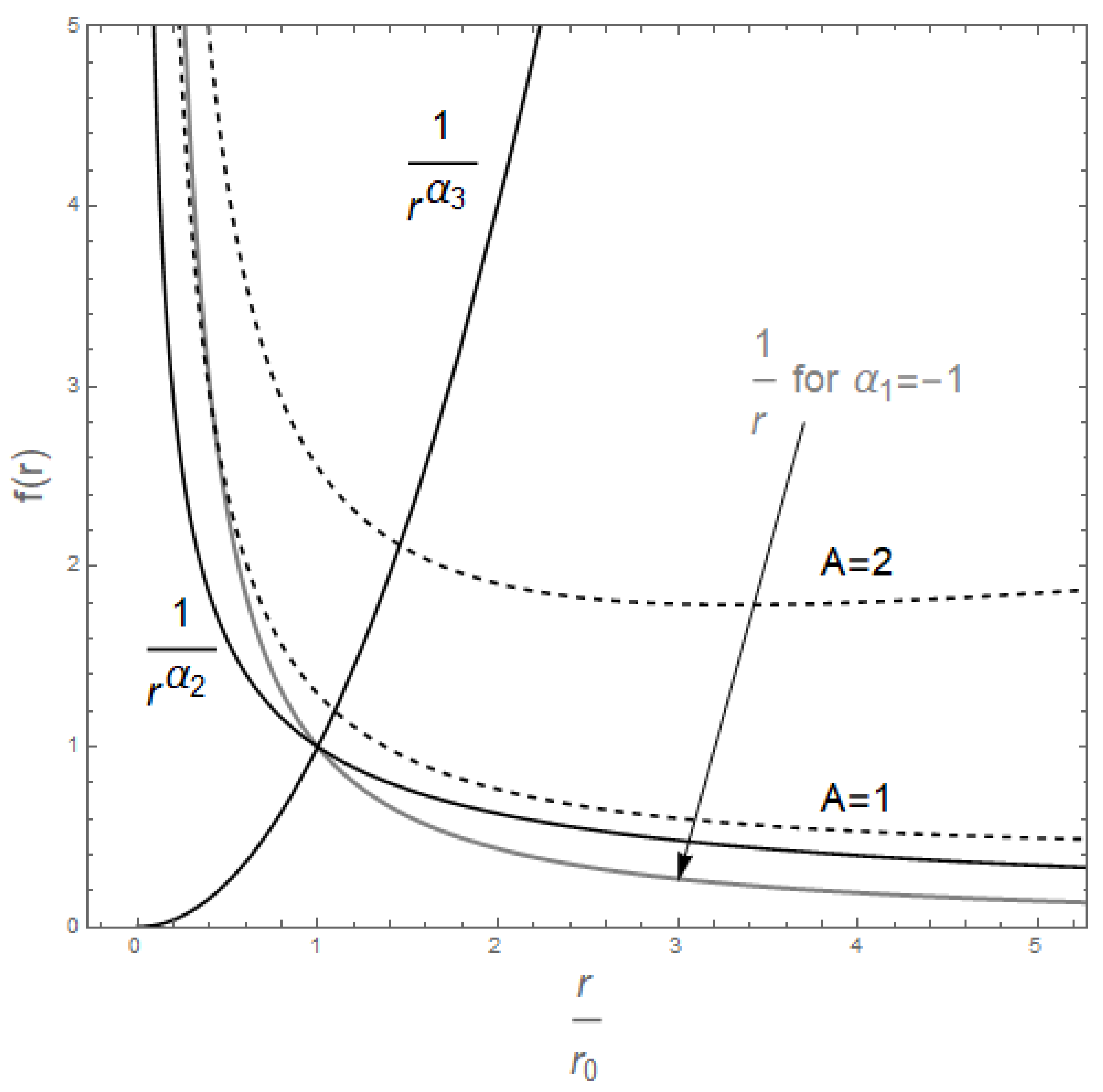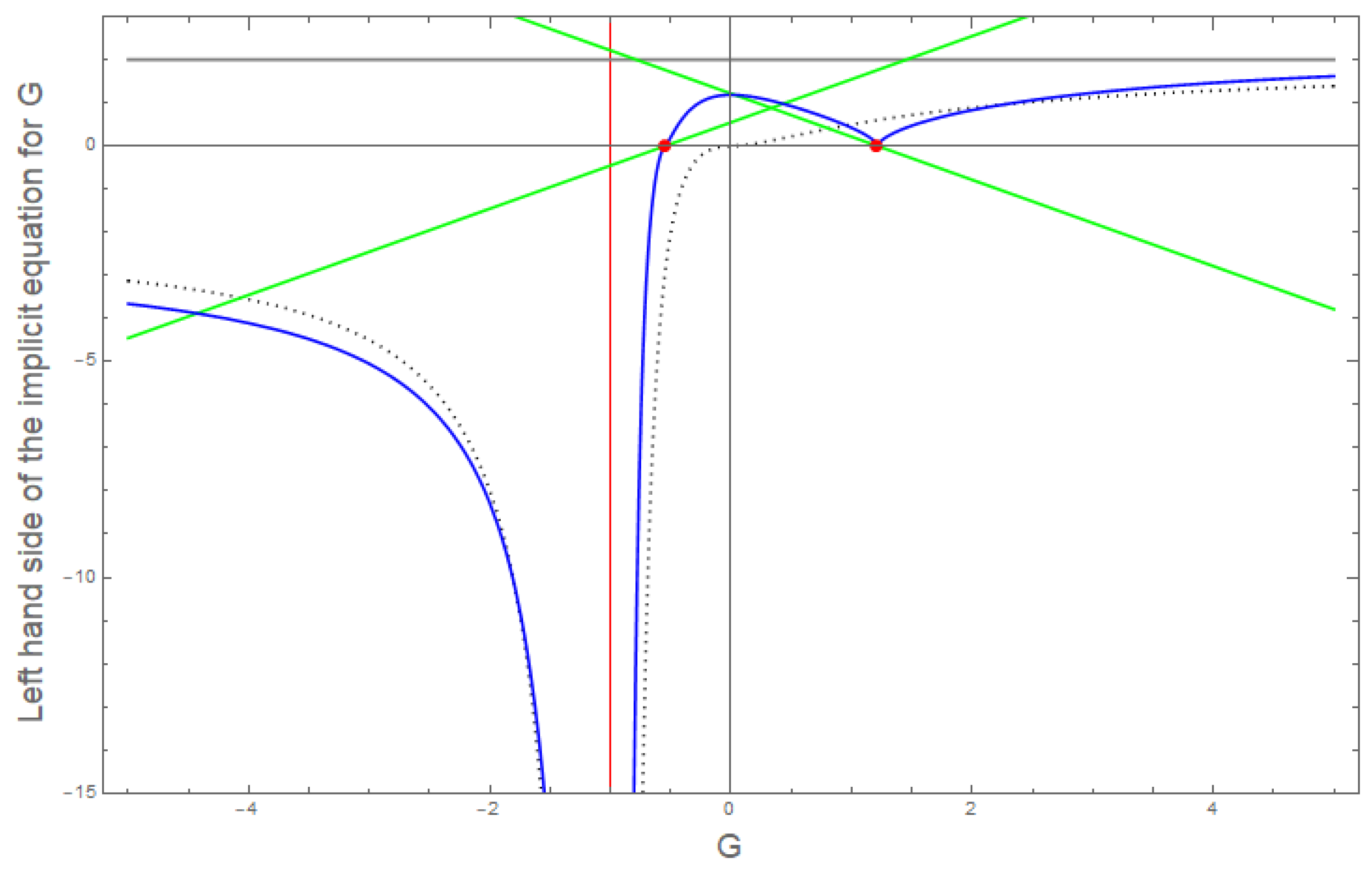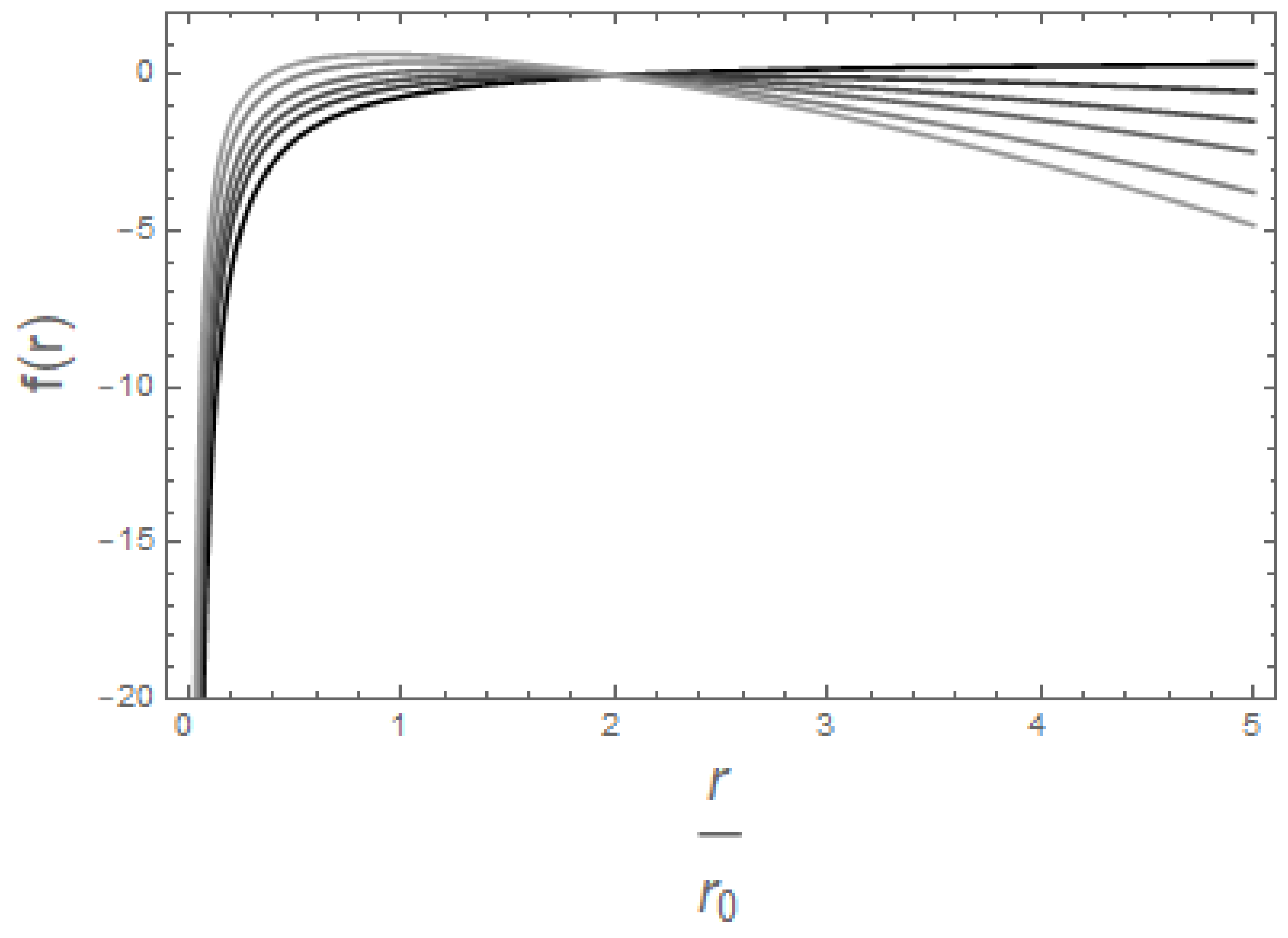Dark Matter and Static, Spherically-Symmetric Solutions of the Extended Einstein Equations
Abstract
1. Introduction
1.1. The Ricci X-Tensor
1.2. The Lagrangian
2. Spherically Symmetric Static Solutions
2.1. Exterior Metric with
2.2. Exterior Solution with Constant
2.3. Charged, Static, Falling Density Ionic Dust
3. Approximate Solutions for a General Form of the Field Equation
3.1. General Form of the Equation
3.2. Particular Case for the Equation
3.3. Approximations
4. Concluding Remarks
Author Contributions
Funding
Data Availability Statement
Conflicts of Interest
References
- Vuille, C. The spacetime between Einstein and Kaluza-Klein. Mod. Phys. Lett. A 2020, 35, 2030020. [Google Scholar] [CrossRef]
- Kaluza, T.S. Zum Unitätsproblem in der Physik. Sitzungsber. Preuss. Akad. Wiss. Berlin. (Math. Phys.) 1921, 33, 966–972. [Google Scholar]
- Klein, O. Quantentheorie und fünfdimensionale Relativitätstheorie. Z. Physik A 1926, 37, 895–906. [Google Scholar] [CrossRef]
- Vuille, C. Nonlinear Operators on Spacetime Manifolds. Ann. N. Y. Acad. Sci. 1991, 631, 246. [Google Scholar] [CrossRef]
- Vuille, C. Proceedings of the 11th Marcel Grossman Meeting; World Scientific: Singapore, 1997; p. 606. [Google Scholar]
- Vuille, C. Exact dark energy cosmologies in extended general relativity. Mod. Phys. Lett. A 2025, 40, 2450232. [Google Scholar] [CrossRef]
- Milgrom, M. A modification of the Newtonian dynamics as a possible alternative to the hidden mass hypothesis. Astrophys. J. 1983, 270, 365–370. [Google Scholar] [CrossRef]
- Zwicky, F. The red shift of extragalactic nebulae. Helv. Phys. A. 1933, 6, 110–127. [Google Scholar]
- Zwicky, F. On the masses of nebulae and of clusters of nebulae. Astrophys. J. 1937, 86, 217. [Google Scholar] [CrossRef]
- Ruben, V.; Ford, K. Rotation of the Andromeda Nebula from a Spectroscopic Survey of Emission Regions. Astrophys. J. 1970, 159, 379. [Google Scholar] [CrossRef]
- Milgrom, M. MOND theory. Can. J. Phys. 2014, 93, 107–118. [Google Scholar] [CrossRef]
- Private Conversation with Demetrios Christodoulu; University of Florida: Gainesville, FL, USA, 1990.
- Adler, R.; Bazin, M.; Schiffer, M. Introduction to General Relativity, 2nd ed.; McGraw-Hill: New York, NY, USA, 1975; p. 188. [Google Scholar]
- Herstein, I.N. Topics in Algebra, 2nd ed.; John Wiley and Sons: Hoboken, NJ, USA,, 1975; p. 175. [Google Scholar]
- Banik, I.; Kroupa, P. Directly testing gravity with Proxima Centauri. MNRAS 2019, 487, 1653. [Google Scholar] [CrossRef]
- Chae, K. Robust Evidence for the Breakdown of Standard Gravity at Low Acceleration from Statistically Pure Binaries Free of Hidden Companions. Astrophys. J. 2024, 960, 114. [Google Scholar] [CrossRef]
- Mistele, T.; McGaugh, S.; Lelli, F.; Schombert, J.; Li, P. Indefinitely Float Circular Velocities and the Baryonic Tully-Fischer Relation from Weak Lensing. arXiv 2024, arXiv:2406.09685v1. [Google Scholar]
- Boehmer, C.G.; Harko, T. Nonlinear stability analysis of the Emden-Fowler equation. J. Nonlin. Math. Phys. 2010, 17, 503. [Google Scholar] [CrossRef]
- Esposito, S. Majorana transformation for differential equations. Int. J. Theoret. Phys. 2002, 41, 2417. [Google Scholar] [CrossRef]
- Arnold, V.I. Ordinary Differential Equations; Springer Science & Business Media: New York, NY, USA, 1992. [Google Scholar]
- Dozmorov, M.; Zadonskii, G.I. Vaidya’s Spherically Symmetric Radiating Solution. Sov. Phys. J. 1971, 14, 1570–1572. [Google Scholar] [CrossRef]
- Vuille, C. (Embry-Riddle Aeronautical University, Daytona Beach, FL, USA). Private Calculation. Unpublished work; 2024. [Google Scholar]



Disclaimer/Publisher’s Note: The statements, opinions and data contained in all publications are solely those of the individual author(s) and contributor(s) and not of MDPI and/or the editor(s). MDPI and/or the editor(s) disclaim responsibility for any injury to people or property resulting from any ideas, methods, instructions or products referred to in the content. |
© 2025 by the authors. Licensee MDPI, Basel, Switzerland. This article is an open access article distributed under the terms and conditions of the Creative Commons Attribution (CC BY) license (https://creativecommons.org/licenses/by/4.0/).
Share and Cite
Vuille, C.; Ludu, A. Dark Matter and Static, Spherically-Symmetric Solutions of the Extended Einstein Equations. Mod. Math. Phys. 2025, 1, 9. https://doi.org/10.3390/mmphys1030009
Vuille C, Ludu A. Dark Matter and Static, Spherically-Symmetric Solutions of the Extended Einstein Equations. Modern Mathematical Physics. 2025; 1(3):9. https://doi.org/10.3390/mmphys1030009
Chicago/Turabian StyleVuille, Chris, and Andrei Ludu. 2025. "Dark Matter and Static, Spherically-Symmetric Solutions of the Extended Einstein Equations" Modern Mathematical Physics 1, no. 3: 9. https://doi.org/10.3390/mmphys1030009
APA StyleVuille, C., & Ludu, A. (2025). Dark Matter and Static, Spherically-Symmetric Solutions of the Extended Einstein Equations. Modern Mathematical Physics, 1(3), 9. https://doi.org/10.3390/mmphys1030009





